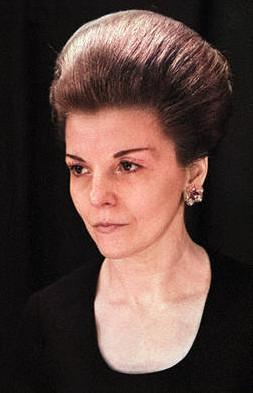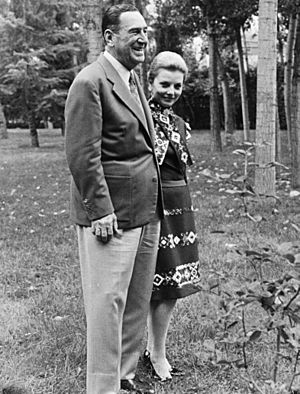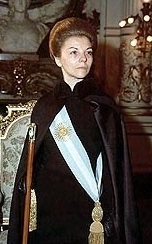Isabel Perón facts for kids
Quick facts for kids
Isabel Perón
|
|
|---|---|

Perón in 1974
|
|
| 41st President of Argentina | |
| In office 1 July 1974 – 24 March 1976 Acting: 29 June 1974 – 1 July 1974 |
|
| Vice President | Herself Vacant |
| Preceded by | Juan Perón |
| Succeeded by | Jorge Rafael Videla |
| 2nd President of the Justicialist Party | |
| In office 1 July 1974 – 21 February 1985 |
|
| Preceded by | Juan Perón |
| Succeeded by | Antonio Cafiero |
| 28th Vice President of Argentina | |
| In office 12 October 1973 – 1 July 1974 |
|
| President | Juan Perón |
| Preceded by | Vicente Solano Lima |
| Succeeded by | Víctor Hipólito Martínez (1983) |
| First Lady of Argentina | |
| In role 12 October 1973 – 1 July 1974 |
|
| President | Juan Perón |
| Preceded by | Norma Beatriz López Rega |
| Succeeded by | Alicia Raquel Hartridge (1976) |
| Personal details | |
| Born |
María Estela Martínez Cartas
4 February 1931 La Rioja, Argentina |
| Political party | Justicialist Party |
| Spouse | |
| Signature |  |
Isabel Martínez de Perón (born María Estela Martínez Cartas on 4 February 1931) is an Argentine politician. She made history as the 41st president of Argentina from 1974 to 1976. She was one of the first women to lead a country as president.
Isabel Perón was the third wife of President Juan Perón. Before becoming president herself, she served as the 29th Vice President and First Lady of Argentina during her husband's time in office from 1973 to 1974. She also led the Justicialist Party from 1974 until 1985.
After her husband passed away in 1974, she became president. She held the position for almost two years until the military took control of the government in 1976. She was then kept under house arrest for five years before moving to Spain in 1981.
When democracy returned to Argentina in 1983, she was invited as a special guest to the inauguration of President Raúl Alfonsín. For some years, she was the official leader of Juan Perón's Justicialist Party and helped with talks to bring people together. However, she has not held an important political role since then.
In 2007, a judge in Argentina ordered her arrest. This was related to a disappearance that happened in 1976. The judge said her orders allowed the military to act against certain groups. She was arrested in Spain, but Spanish courts decided not to send her back to Argentina. As of 2025, Isabel Perón is the oldest living former Argentine president.
Contents
Early Life and Political Beginnings
María Estela Martínez Cartas was born in La Rioja, Argentina. She left school after fifth grade. In the early 1950s, she became a nightclub dancer and chose the name Isabel. This name was inspired by a saint.
Meeting Juan Perón
Isabel met her future husband, Juan Perón, when he was living in Panama. Juan Perón was much older than her. He was looking for companionship after his second wife, Eva Perón (Evita), passed away in 1952.
Perón brought Isabel with him when he moved to Madrid, Spain, in 1960. The authorities there did not approve of them living together without being married. So, on 15 November 1961, Juan Perón married Isabel.
Starting in Politics
Juan Perón was not allowed to return to Argentina after being removed from power in 1955. While he was in exile, Isabel became his link between Spain and Argentina. She traveled to Argentina on his behalf.
During this time, Isabel met José López Rega in 1965. He was a former police officer who was interested in fortune-telling. Isabel was also interested in such topics, and they quickly became friends. Isabel convinced Perón to make López Rega his personal secretary. López Rega later started a group called the Argentine Anticommunist Alliance.
Becoming Vice President
In 1973, Perón's party chose Héctor José Cámpora to run for president. Cámpora won, but many people knew that Juan Perón was still the real power behind the scenes. Later that year, Perón returned to Argentina, and Cámpora resigned. This allowed Juan Perón to run for president himself.
Juan Perón chose Isabel as his Vice President. He did this to help unite different groups within his party who were arguing. Juan Perón's health was not good at this time. Because of this, Isabel had to step in as acting president several times during his term.
Presidency (1974–1976)
Juan Perón had several heart attacks and passed away on 1 July 1974. He had been president for less than a year in his third term. As Vice President, his wife Isabel officially became president. She was the first woman in the world to hold the title of "President." People often called her La Presidente.
At first, many people supported Isabel Perón, even though she was not as charismatic as Evita Perón. She promised to continue her husband's policies. Her first major economic decisions included a new law to help workers and giving a state oil company control over gas stations. Even groups that had disagreed with Juan Perón offered her their support.
However, she started canceling meetings with different groups. The public's sympathy for her soon faded. Her government removed many left-leaning people from university jobs and government positions. She also used special powers to remove governors who were not aligned with her.
Growing Political Tensions
A big concern for voters was the increasing influence of José López Rega. He was the Minister of Social Welfare and seemed to control many of Perón's policies. He reviewed almost all decisions about Argentina's internal affairs and foreign relations. His strange public behavior also made the public lose trust in the president.
López Rega's group, the Argentine Anticommunist Alliance (Triple A), was a right-wing group that caused violence. At the same time, left-wing groups like the Montoneros and the People's Revolutionary Army (ERP) also carried out violent acts. This led to a period of increasing political violence in Argentina.
To try and stop the violence, Perón declared a state of siege on 6 November 1974. This meant that some constitutional rights were suspended. Censorship also increased, and some newspapers and TV shows were shut down.
In February 1975, a military campaign called "Operation Independence" began in Tucumán. This operation aimed to fight against armed groups.
Economic Challenges
Isabel Perón tried to continue her husband's economic plan, which included a "Social Pact." This plan aimed to balance prices and wages. However, inflation started to rise quickly.
In June 1975, the new Economy Minister, Celestino Rodrigo, introduced harsh economic changes. These changes doubled prices for services and cut the value of the Argentine currency in half. This caused prices to skyrocket and led to widespread protests across Argentina. There was even a general strike, which was the first against a Peronist government. After these protests, the unpopular José López Rega left the country and went into exile.
The Fall of Her Government
After López Rega left, Perón made some changes in her government. She replaced her Economy Minister and the head of the Armed Forces. She also took a leave of absence due to health issues. During this time, it was hoped that she might not return to power.
Political violence continued to grow in 1975. Both the left-wing ERP and the right-wing Triple A carried out attacks. More than 700 people died from political violence during her first 15 months in office.
To try and calm the public, the military, and labor leaders, Perón signed new measures on 6 October. These measures gave the Armed Forces broad powers to "annihilate subversive elements." This extended the state of siege across the country. This decision helped her regain enough support to return to her post.
However, Perón's health remained weak. Economic problems also continued. Inflation was still very high, and the economy was shrinking. The government faced large budget deficits and a lack of foreign money.
In December 1975, a general in the Air Force tried to stage a coup, but it was stopped. The People's Revolutionary Army (ERP) also attacked a military base, which marked the end of their violent campaign.
Allegations of corruption against Perón also surfaced. A congressional investigation began in November 1975. This caused her to lose support in Congress.
In early 1976, Isabel Perón made more policy changes to please the military. The Economy Minister was replaced, and new harsh economic measures were announced. These measures caused prices to more than double in three months, leading to more strikes.
The opposition party started a process to remove the president from office in February. The media openly discussed the possibility of a military coup. On 23 March 1976, after working late, Perón was alerted to suspicious military activity. She boarded the presidential helicopter, but it took her to an Air Force base instead of her home. There, she was officially removed from power and arrested.
Detention and Life After Presidency
After the military took over, many government officials were arrested. Isabel Perón herself was kept under house arrest for five years. In July 1981, she was sent to live in Spain. She remained the official head of her husband's Justicialist Party until she resigned in February 1985.
When democracy returned to Argentina in 1983, Perón was pardoned for corruption charges. She returned to Argentina in December 1983 as a special guest at President Raúl Alfonsín's inauguration. She also participated in talks to help unite political groups. She supported cooperation between the main labor union and Alfonsín's government. After these talks, she resigned from her role as the party leader.
She returned to Argentina in 1988 to deal with legal matters about Juan Perón's property. After that, she went back to Spain and lived a very private life. In October 2024, she met with Vice President Victoria Villarruel to show national unity. On the same day, she unveiled a statue of Perón in the Senate.
Arrest in Spain and Legal Decisions
In November 2006, a judge in Argentina asked for testimony from Isabel Perón about disappearances that happened during her presidency. On 12 January 2007, she was arrested by police in Madrid, Spain. She was accused of involvement in a disappearance in February 1976 and for her decree in October 1975 that allowed the military to act against certain groups.
However, Spain's National Court refused to send her back to Argentina. They ruled that the charges against her were not considered crimes against humanity. They also said that the time limit for these charges had passed after 20 years. In June 2017, Argentina's highest court also dismissed requests to question Isabel Perón.
Recent Years
In 2024, the current President, Javier Milei, invited all living former presidents to a special signing event in July 2024. However, Isabel Perón chose not to attend.
See also
 In Spanish: María Estela Martínez de Perón para niños
In Spanish: María Estela Martínez de Perón para niños
- National Reorganisation Process



